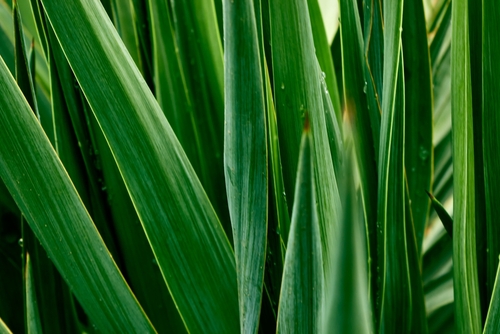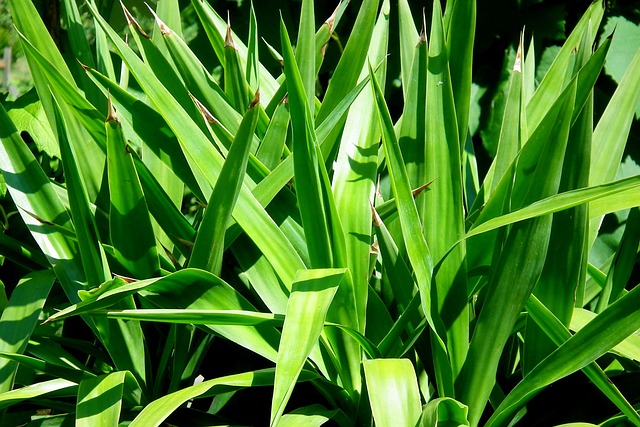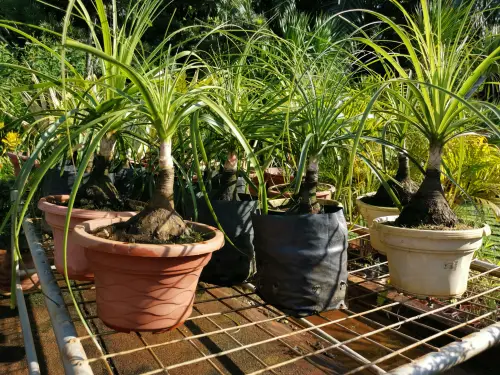Yuccas are popular plants known for their sword-shaped evergreen leaves and stunning white flowers. However, if you notice white spots on the leaves of your Yucca plant, it can be concerning. White spots on Yucca leaves can indicate a range of issues, from pests and diseases to environmental factors.
Identifying the cause of white spots on Yucca leaves is crucial to managing the problem effectively. Common causes of white spots on Yucca leaves include powdery mildew, mealybug infestations, and spider mites.
Disease and pest management, preventive measures, and proper maintenance can help control and prevent white spots on Yucca leaves. It is also essential to take safety precautions when handling Yuccas, as they can be sharp and prickly.
Key Takeaways
- White spots on Yucca leaves can indicate a range of issues, from pests and diseases to environmental factors.
- Common causes of white spots on Yucca leaves include powdery mildew, mealybug infestations, and spider mites.
- Disease and pest management, preventive measures, and proper maintenance can help control and prevent white spots on Yucca leaves.
Check out these other posts:
- White Spots on Underside of Leaves
- White Spots on Succulent Leaves
- White Spots on Squash Leaves and Stems
Identifying White Spots on Yucca Leaves

Yucca plants are known for their sword-shaped evergreen leaves that add a touch of greenery and elegance to any space. However, white spots on yucca leaves can be a sign of a problem that needs attention.
The white spots on yucca leaves can be caused by various factors. One of the most common causes is powdery mildew, a fungal disease that thrives in humid conditions. Powdery mildew appears as white or gray powdery spots on the leaves, and it can spread rapidly if left untreated.
Another possible cause of white spots on yucca leaves is scale insects. These tiny insects attach themselves to the leaves and feed on the sap, leaving behind white or yellow spots. Mealybugs and spider mites can also cause white spots on yucca leaves.
To identify the cause of the white spots on yucca leaves, it is important to inspect the plant closely. If the spots are powdery and appear on the upper and lower surfaces of the leaves, it is likely powdery mildew. If the spots are raised and appear on the undersides of the leaves, it could be scale insects or mealybugs.
In addition to white spots, other symptoms may be present depending on the cause of the problem. For example, if the white spots are caused by powdery mildew, the leaves may also appear wilted or distorted. If the white spots are caused by scale insects or mealybugs, the leaves may have a sticky residue or appear yellowed.
White Spots on Yucca Leaves – 7 Common Problems
Yucca plants are known for their sword-shaped evergreen leaves and stunning white flowers. However, if you notice white spots on the leaves, it could indicate a problem. Here are some common causes of white spots on yucca leaves:
1. Pests
Mealybugs and spider mites are common pests that can cause white spots on yucca leaves. Mealybugs have a cotton-like appearance and feed on the leaves, causing dehydration and other problems.
Spider mites are tiny pests that can also cause white spots on the leaves. They feed on the plant’s sap and can cause significant damage if left untreated.
2. Overwatering
Overwatering can cause white spots on yucca leaves. When the plant is overwatered, the roots may become waterlogged, leading to root rot. This can cause the leaves to turn yellow and develop white spots. It’s essential to water yucca plants correctly and avoid overwatering.
3. Temperature

Yucca plants prefer warm temperatures and can be sensitive to cold temperatures. Exposure to cold temperatures can cause the leaves to turn yellow and develop white spots. It’s essential to keep yucca plants in a warm environment to prevent this problem.
4. Direct Sunlight
While yucca plants need plenty of sunlight to thrive, direct sunlight can cause sunburn and white spots on the leaves. It’s best to place yucca plants in a location where they receive indirect sunlight or partial shade.
5. Indirect Light
On the other hand, yucca plants that don’t receive enough light can also develop white spots on the leaves. It’s essential to find a balance between direct and indirect light to prevent this problem.
6. Moist Environment
Yucca plants prefer a dry environment and can be sensitive to excess moisture. A moist environment can cause fungal diseases like powdery mildew, which can cause white spots on the leaves. It’s essential to ensure proper drainage and avoid overwatering to prevent this problem.
7. Wind
Strong winds can cause physical damage to yucca plants, leading to white spots on the leaves. It’s essential to protect yucca plants from strong winds and provide support if necessary.
Disease and Pest Management
Yucca plants can be prone to pests and diseases, which can cause white spots on their leaves. Here are some tips for managing these issues:
1. Pest Infestation
If you notice white spots on your Yucca leaves, it could be a sign of a pest infestation. Common pests that affect Yucca plants include mealybugs and spider mites. These pests can be treated with neem oil, which is a natural insecticide.
Simply mix a few drops of neem oil with water and spray the solution on the affected leaves. Repeat this process every few days until the pests are gone.
2. Fungal Diseases

Powdery mildew is a common fungal disease that can cause white spots on Yucca leaves. This disease thrives in humid environments, so it’s important to keep your Yucca plant in a well-ventilated area.
If powdery mildew is present, it can be treated with a fungicide. Copper fungicide is a popular option for treating powdery mildew. Follow the instructions on the package for best results.
3. Pruning
Pruning is an important part of Yucca plant care. Regular pruning can help prevent pest infestations and fungal diseases. Remove any dead or yellowing leaves as soon as you notice them. This will prevent the spread of disease and keep your plant looking healthy.
4. Fertilizing
Proper fertilization is also important for Yucca plant health. Use a balanced fertilizer once a month during the growing season. This will help your plant grow strong and healthy, making it less susceptible to pests and diseases.
5. DIY Remedies
If you prefer to use natural remedies, there are a few options you can try. Rubbing alcohol can be used to kill mealybugs and other pests. Simply dip a cotton swab in rubbing alcohol and apply it to the affected leaves.
Dish soap can also be used to kill pests. Mix a few drops of dish soap with water and spray the solution on the affected leaves. Repeat this process every few days until the pests are gone.
Preventive Measures and Maintenance
To prevent white spots on yucca leaves, it is important to maintain proper plant care and take preventive measures. Here are some tips to help keep your yucca plant healthy and spot-free:
- Remove infected foliage: If you notice any leaves with white spots, remove them immediately. This will prevent the spread of any diseases or pests to other parts of the plant.
- Address problems promptly: If you notice any problems with your yucca plant, such as wilting or discoloration, address them promptly. This will prevent any issues from becoming more severe and potentially causing white spots on the leaves.
- Watch out for bugs: Yucca plants can be susceptible to pests such as spider mites, mealybugs, and scale insects. Keep an eye out for any signs of infestation, such as webbing or sticky residue on the leaves.
- Keep other plants away: Yucca plants can be sensitive to other plants. Keep them away from any plants that may be prone to disease or pests.
- Provide proper shade: Yucca plants prefer bright but indirect sunlight. Too much direct sunlight can cause sunburn, which can lead to white spots on the leaves.
- Maintain healthy foliage and flowers: Keep the foliage and flowers of your yucca plant healthy and well-maintained. This will help prevent any issues that could lead to white spots on the leaves.
- Protect seeds and roots: Yucca plants can produce seeds and have a deep root system. Protect these parts of the plant to prevent any damage that could lead to white spots on the leaves.
- Check stems and sap: Check the stems and sap of your yucca plant for any signs of damage or disease. This will help prevent any issues from spreading to the leaves.
- Repot as needed: Repot your yucca plant as needed to ensure it has enough room to grow. This will help prevent any stress that could lead to white spots on the leaves.
- Avoid overhead watering: Yucca plants prefer to be watered at the base of the plant, rather than from above. Overhead watering can lead to moisture on the leaves, which can cause white spots.
- Ensure good airflow and drainage: Yucca plants prefer well-draining soil and good airflow. Ensure your plant has proper drainage and is not sitting in water, and provide adequate ventilation to prevent any issues that could lead to white spots on the leaves.
Other Potential Issues

Aside from white spots, yucca leaves can also experience other issues that may affect their overall health and appearance. Here are some of the potential issues that yucca owners should be aware of:
1. Brown Spots
Brown spots on yucca leaves can be caused by a variety of factors, including overwatering, underwatering, and exposure to extreme temperatures. If the brown spots are caused by overwatering, then it’s important to reduce watering frequency and ensure that the soil is well-draining.
If the brown spots are caused by underwatering, then it’s important to increase watering frequency and ensure that the soil is moist but not waterlogged. If the brown spots are caused by extreme temperatures, then it’s important to move the yucca to a more suitable location.
2. Yellow Leaves
Yellow leaves on yucca plants can be caused by a variety of factors, including underwatering, overwatering, and nutrient deficiencies. If the yellow leaves are caused by underwatering, then it’s important to increase watering frequency and ensure that the soil is moist but not waterlogged.
If the yellow leaves are caused by overwatering, then it’s important to reduce watering frequency and ensure that the soil is well-draining. If the yellow leaves are caused by nutrient deficiencies, then it’s important to fertilize the plant with a suitable fertilizer.
3. Honeydew
Honeydew is a sticky substance that can accumulate on yucca leaves and is caused by sap-sucking insects such as mealybugs and scale insects. If left untreated, honeydew can attract ants and promote the growth of sooty mold, a black fungus that can further damage the plant.
To get rid of honeydew, it’s important to treat the underlying insect infestation with an appropriate insecticide.
4. Lower Leaves
It’s normal for yucca plants to shed their lower leaves as they grow, but if the lower leaves are turning yellow or brown prematurely, then it could be a sign of a problem.
This could be caused by a variety of factors, including overwatering, underwatering, and nutrient deficiencies. It’s important to identify the underlying cause and take appropriate action.
5. Fungal Diseases
Yucca plants can be susceptible to fungal diseases such as leaf spot and root rot. These diseases can be caused by overwatering, poor drainage, and high humidity. To prevent fungal diseases, it’s important to ensure that the soil is well-draining, avoid overwatering, and maintain good air circulation around the plant.
6. Black Spots
Black spots on yucca leaves can be caused by a variety of factors, including fungal diseases, insect infestations, and sunburn. If the black spots are caused by fungal diseases or insect infestations, then it’s important to treat the underlying problem with appropriate fungicides or insecticides.
If the black spots are caused by sunburn, then it’s important to move the plant to a more suitable location with less direct sunlight.
Safety Precautions When Handling Yuccas

Yuccas are generally healthy and hardy outdoor plants that can add a touch of the Caribbean to any garden. However, homeowners should be aware that these plants can be toxic and cause skin irritation. Therefore, it is important to take some safety precautions when handling yuccas.
Firstly, it is important to wear gloves and protective clothing when handling yuccas. This is because the leaves of the plant can be sharp and cause cuts. Additionally, yuccas contain saponins, which can cause skin irritation and even vomiting if ingested. Therefore, homeowners should avoid touching their face or mouth while handling yuccas.
Secondly, it is important to be careful when propagating yuccas from cuttings. While this is a common method of reproducing yuccas, it is important to handle the cuttings with care.
The sharp leaves can easily cause cuts, and the sap can cause skin irritation. Therefore, homeowners should wear gloves and protective clothing when handling yucca cuttings.
Thirdly, if homeowners need to destroy yuccas due to disease or other issues, they should be careful when handling the plants. It is important to wear gloves and protective clothing, and to dispose of the plants carefully. Homeowners should avoid composting yuccas, as this can spread disease to other plants.
Lastly, if homeowners need to use fungicides to treat yucca diseases, they should follow the instructions carefully. Fungicides can be toxic, and homeowners should wear gloves and protective clothing when applying them.
Additionally, homeowners should avoid using fungicides on healthy yuccas, as this can harm the plant and cause unnecessary damage.
Conclusion
White spots on yucca leaves can be caused by a variety of factors such as excess humidity, pests, or fungal diseases like powdery mildew. If left untreated, these spots can spread and eventually lead to the death of the plant.
To prevent white spots on yucca leaves, it is important to ensure that the plant is placed in a location with adequate sunlight and good air circulation. Overwatering should be avoided, as this can lead to excess humidity and the growth of fungal diseases.
If white spots do appear on yucca leaves, the affected areas should be trimmed off and the plant should be treated with a fungicide or insecticide, depending on the cause of the spots. It is important to follow the instructions on the product label carefully to avoid damaging the plant.
Frequently Asked Questions

How do you get rid of powdery mildew on yucca plants?
Powdery mildew is a common fungal disease that can affect yucca plants. To get rid of it, you can use a fungicide that is specifically designed to treat powdery mildew.
You can also try using a homemade solution of water and baking soda or neem oil. It’s important to keep the affected leaves dry and to remove any infected leaves as soon as possible.
How do you treat yucca leaf spots?
Yucca leaf spots can be caused by a variety of factors, including fungal diseases, nutrient deficiencies, and pests. To treat yucca leaf spots, you first need to identify the underlying cause.
If it’s a fungal disease, you can use a fungicide to treat the affected plant. If it’s a nutrient deficiency, you can fertilize the plant with a balanced fertilizer. If it’s a pest infestation, you can use an insecticide to get rid of the pests.
What causes white spots on plant leaves?
White spots on plant leaves can be caused by a variety of factors, including fungal diseases, pests, nutrient deficiencies, and environmental stress. Powdery mildew is a common fungal disease that can cause white spots on plant leaves.
Scale insects and spider mites are common pests that can also cause white spots. Nutrient deficiencies, such as a lack of calcium or magnesium, can cause white spots as well.
How do you prevent white spots on leaves?
To prevent white spots on leaves, it’s important to maintain a healthy growing environment for your plants. This includes providing adequate light, water, and nutrients. You can also use preventative measures, such as applying a fungicide or insecticide, to keep your plants healthy and free of pests and diseases.
What are some common fungal diseases that affect yucca plants?
Some common fungal diseases that affect yucca plants include powdery mildew, root rot, and leaf spot. Powdery mildew is a fungal disease that causes a white, powdery coating on the leaves.
Root rot is a fungal disease that affects the roots of the plant and can cause the plant to wilt and die. Leaf spot is a fungal disease that causes brown spots on the leaves.
How do you identify and treat yucca trunk rot?
Yucca trunk rot is a fungal disease that affects the trunk of the plant. It can cause the trunk to become soft and mushy, and can eventually lead to the death of the plant.
To identify yucca trunk rot, look for soft, mushy areas on the trunk of the plant. To treat it, you can try cutting away the affected areas and applying a fungicide to the remaining trunk. In severe cases, it may be necessary to remove the entire plant.

Hey, I’m Lisa and I’ve been an avid gardener for over 30 years. I love writing, talking and living in the garden! Feel free to connect with me on my socials below


